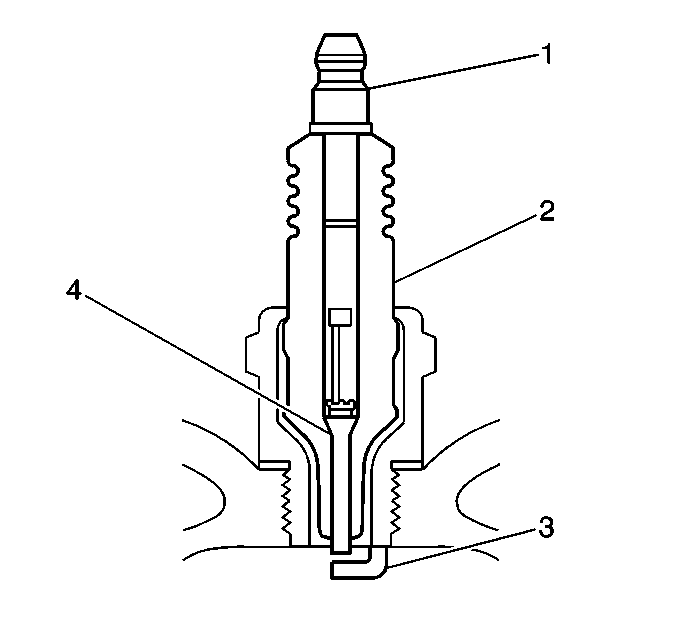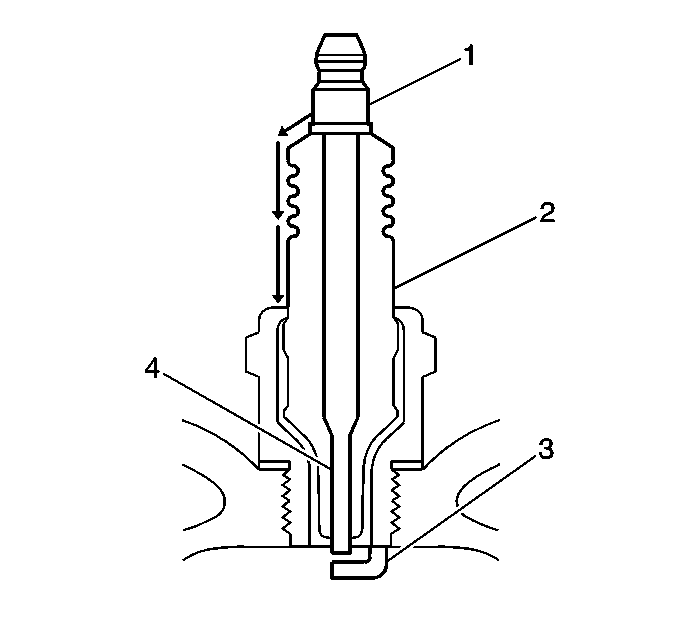Chevrolet Sonic Repair Manual: Spark Plug Inspection
- Spark Plug Usage
-
- Ensure that the correct spark plug is installed. An incorrect spark plug causes driveability conditions.
- Ensure that the spark plug has the correct heat range. An incorrect heat range causes the following conditions:
- Spark plug fouling?older plug
- Pre-ignition causing spark plug and/or engine damage?otter plug
- Spark Plug Inspection
-
- Inspect the terminal post (1) for damage.

- Inspect for a bent or broken terminal post (1).
- Test for a loose terminal post (1) by twisting and pulling the post. The terminal post (1) should NOT move.

- Inspect the insulator (2) for flashover or carbon tracking, soot. This is caused by the electrical charge traveling across the insulator (2) between the terminal post (1) and ground. Inspect for the following conditions:
- Inspect the spark plug boot for damage.
- Inspect the spark plug recess area of the cylinder head for moisture, such as oil, coolant, or water. A spark plug boot that is saturated causes arcing to ground.

- Inspect the insulator (2) for cracks. All or part of the electrical charge may arc through the crack instead of the electrodes (3, 4).

- Inspect for evidence of improper arcing.
- Measure the gap between the center electrode (4) and the side electrode (3) terminals. An excessively wide electrode gap can prevent correct spark plug operation.
- Inspect for the correct spark plug torque. Insufficient torque can prevent correct spark plug operation. An over torqued spark plug, causes the insulator (2) to crack.
- Inspect for signs of tracking that occurred near the insulator tip instead of the center electrode (4).
- Inspect for a broken or worn side electrode (3).
- Inspect for a broken, worn, or loose center electrode (4) by shaking the spark plug.
- A rattling sound indicates internal damage.
- A loose center electrode (4) reduces the spark intensity.
- Inspect for bridged electrodes (3, 4). Deposits on the electrodes (3, 4) reduce or eliminates the gap.
- Inspect for worn or missing platinum pads on the electrodes (3, 4) If equipped.
- Inspect for excessive fouling.
- Inspect the spark plug recess area of the cylinder head for debris. Dirty or damaged threads can cause the spark plug not to seat correctly during installation.
- Spark Plug Visual Inspection
-
- Normal operation?rown to grayish-tan with small amounts of white powdery deposits are normal combustion by-products from fuels with additives.
- Carbon Fouled?ry, fluffy black carbon, or soot caused by the following conditions:
- Rich fuel mixtures
- Leaking fuel injectors
- Excessive fuel pressure
- Restricted air filter element
- Incorrect combustion
- Reduced ignition system voltage output
- Weak coils
- Worn ignition wires
- Incorrect spark plug gap
- Excessive idling or slow speeds under light loads can keep spark plug temperatures so low that normal combustion deposits may not burn off.
- Deposit Fouling?il, coolant, or additives that include substances such as silicone, very white coating, reduces the spark intensity. Most powdery deposits will not effect spark intensity unless they form into a glazing over the electrode.
 Secondary Air Injection System Description
Secondary Air Injection System Description
The Secondary Air Injection System aids in the reduction of hydrocarbon exhaust
emissions during a cold start. This occurs when the start-up engine coolant temperature
(ECT) is between −10 t ...
 Spark Plug Replacement
Spark Plug Replacement
Spark Plug Replacement
Callout
Component Name
Preliminary Procedure
Open the hood.
Remove the engine sight shield.
Remove t ...
Other materials:
All-Season Tires
This vehicle may come with all-season tires. These tires are designed to provide
good overall performance on most road surfaces and weather conditions. Original
equipment tires designed to GM's specific tire performance criteria have a TPC specification
code molded onto the sidewall. Origi ...
Rear Compartment Lid Lock Cylinder Coding
The rear compartment lid lock cylinder uses 7 of the 7 cut positions. The tumbler
positions are staggered from side to side, 4 on one side and 3 on the other, are
not self-retaining, and are not snap in.
Note: All lock cylinders for side milled keys have right and left
tum ...
Transmission Fluid Pump, Front Differential Carrier Baffle, and Front Differential
Ring Gear Installation (6T40/45)
Transmission Fluid Pump, Front Differential Carrier Baffle, and Front
Differential Ring Gear Installation
Callout
Component Name
1
Torque Converter and Differential Housing Seal
2
Fluid Pu ...
0.0061
